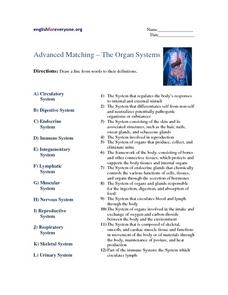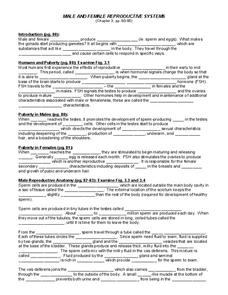The School of Life
Philosophy - Schopenhauer
Are love and the will to life at odds? Arthur Schopenhauer's take on human nature and the importance of love—as well as the unimportance of happiness—is the focus of a philosophy video that compares Schopenhauer's worldview to Buddhism.
Howard Hughes Medical Institute
X Inactivation
Have you ever wondered why calico cats have such a colorful coat? The process of X inactivation is an interesting phenomenon in females that drives the physical appearance of individuals. Viewers of an intriguing video connect knowledge...
Teacher's Pet
Formation of Gametes
The smallest cell in a human body is sperm while the largest cell in a human body is an egg. The video discusses the formation of gametes from a scientific perspective. It includes the process of spermatogenesis, oogenesis and concludes...
FuseSchool
Sperm and Eggs Cells
A human egg cell measures more than 30 times the size of a human sperm cell. An engaging video in the Fuse School playlist discusses the differences between sperm and egg cells. It highlights the reasons for the differences as they come...
Deep Look
This Vibrating Bumblebee Unlocks a Flower's Hidden Treasure
Some plants lock their pollen up until feeling the correct password. The video explains buzz pollination and how it differs from the pollination of other types of flowering plants. It lists multiple plants that require it and...
Delaware Health and Social Services
Set Your Mind, Set Your Goals
Becoming a woman can be overwhelming for girls. An educational resource assists female learners in setting goals for their reproductive choices, physical health, and emotional and mental well-being.
WindWise Education
Are Birds Impacted by Small Wind Turbines?
How do we know if the wind turbine at our school is impacting birds? Here, small groups work together and conduct field work in order to determine the impact of a human-made structure on birds. The groups also determine their searcher...
Nemours KidsHealth
Human Body Series - The Five Senses
Get your class up and moving with these engaging hands-on-activities that target their five senses. Children explore four different work stations that require them to look, smell, hear, touch, and taste as they record their responses...
Curated OER
Continuing Life
In this reproduction worksheet, students will review the genetic processes in sexual reproduction and asexual reproduction by answering 6 true or false statements. Then students will complete 2 short answer questions about the offspring...
Curated OER
Advanced Matching - The Organ Systems
What's the difference between the digestive system and the endocrine system? Explore 12 body systems in this anatomy matching worksheet, for which learners find descriptions corresponding to anatomical terminology. Some of the...
Curated OER
Reproduction
In this reproduction activity, high schoolers review the processes involved with sexual reproduction in animals and pollination in plants. This activity has 6 fill in the blank, 5 true or false, and 9 short answer questions.
Be Smart
Why Do Disney Princesses All Look like Babies?
Could Disney be tricking people into caring about their characters? It seems the design of characters in recent years triggers our nurturing instincts. A video explains the science behind these instinctual habits—and why viewers are so...
Curated OER
Male and Female Reproductive Systems
In this reproductive system worksheet, students review what causes puberty to occur in males and females. Students also review the male and female reproductive anatomy. This worksheet has 50 fill in the blank statements.
Compassion in World Farming Trust
Selective Breeding of Farm Animals
Biology learners read about selective breeding in chickens and how it has produced high-yield meat specimens and rapid egg-layers. The unpleasant effects of artificial selection are explored, as well as options to supporting this...
Khan Academy
Variation in a Species
If there are no extenuating environmental factors to ensure competition in a species, then variation is achieved by random mutation. This resource may be more useful after viewers are introduced to the concepts of alleles and the...
Khan Academy
Introduction to Evolution and Natural Selection
The evidence for natural selection is presented as a random variation of a characteristic allowing a particular strain of organism to survive with a higher probability of successful reproduction. Population change over a short period of...
Curated OER
Human Heredity Vocabulary
Ninth graders review the terms "aneuploidy," "fetus," and "karyotype" in this vocabulary activity, which includes three multiple choice questions about each term. This activity could be expanded into a more developed vocabulary lesson in...
TED-Ed
What Is Leukemia?
Leukemia afflicts children more than any other type of cancer. Pupils explore the nature of harmful mutations in cell DNA, the reproduction of damaged cells in blood and bone marrow, and their effect on normal functions of the human body.
Crash Course
Peripheral Nervous System
The brain does not feel pain, which is why surgeons can perform brain surgery without anesthesia or while the patient is awake. Pupils see how the peripheral nervous system allows humans to feel pain. The narrator explores the afferent...
Crash Course
Tissues (Part 1)
Once a nerve cell is damaged, it cannot be reproduced. Video number two in a series of 47 introduces high schoolers to tissues, focusing on the four types: nervous, muscle, epithelial, and connective. The narrator teaches their roles in...
Crash Course
The Skeletal System
Humans have 54 bones in their hands, fingers, and wrists, allowing for a variety of movement. The 19th video in a series of 47 introduces learners to the anatomy of the skeletal system. The narrator teaches about flat, short, and...
Crash Course
The Integumentary System – Skin Deeper (Part 2)
The thinnest skin on your body is found on your eyelids, and the thickest is found on the soles of your feet. This seventh video in a series of 47 explores how the integumentary system protects people and also helps them interact with...
Crash Course
Blood – True Blood (Part 1)
Teach your class about human blood and explain why donation is so important using the 29th video in a series of 47. Learners explore the basic components of blood, how cuts stop bleeding, and how antigens determine blood types.
Crash Course
Tissues – Epithelial Tissue (Part 2)
Epithelial tissues plays a variety of roles in the human body, including covering, lining, making a barrier, protection, excretion, filtration, absorption, and sensation. The video teaches high schoolers about epithelial tissue and its...
Other popular searches
- Sexual Reproduction in Human
- Human Reproduction Labs
- Human Reproduction Anatomy
- Human Reproduction Videos
- Human Reproduction Systems
- Human Reproduction Biology
- Human Reproduction Cycle
- Human Reproduction Development
- Human Reproduction Science
- Test on Human Reproduction
- Human Reproduction Worksheet
- Reproduction Human

























